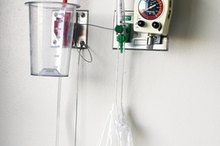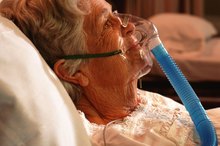Oxygen Saturation Exercise
Your red blood cells carry oxygenated blood throughout the entire body. In apparently healthy adults, the red blood cells that pass through the lungs are between 95 and 100 percent saturated with oxygen. Each red blood cell is able to carry four molecules of oxygen. Oxygen saturation is the measure of how much oxygen each red blood cell is carrying. It is also expressed as Sp02.
Invasive Test
Oxygen saturation can be measured in one of two ways. A blood gas analysis is one direct method to measure oxygen levels. During this invasive test a small amount of blood is drawn out of an artery. This is different from most lab draws, because they are usually drawn from a vein. The radial artery on the wrist is the most common site for an arterial blood gas draw.
Noninvasive Test
How to Set Up the Flow Meter on a Oxygen Concentrator
Learn More
The second, noninvasive method is through the use of a pulse oximeter. An oximeter is a clip, normally placed on the finger, that emits a light on one side. When placed on the finger, the light is measured as it comes through the other side of the finger. It works on the principle that oxygen saturated cells absorb light differently than those that are not. The oximeter gives out a digital reading of your estimated blood oxygen level.
Activity Response
Normal oxygen levels of 95 to 100 percent allow the proper pressure within the body to allow the oxygen to be absorbed into the muscles. If your levels at rest are in the normal range, that also allows for a small supply of oxygen to be stored in the muscles. Once you begin to exercise, your rate and depth of respiration increases to help meet the increase in oxygen demands. A normal response in regards to oxygen saturation is a possible drop of only 2 to 3 percent. Ideally, that level will stay above 92 percent during exercise to keep the proper pressure of oxygen in the blood.
Hypoxemia
How to Finger Prick to Check Iron Levels
Learn More
Low blood oxygen levels, or hypoxemia, are those below 90 percent. Several medical conditions can cause hypoxemia. These include COPD, emphysema, anemia, pulmonary embolism, sleep apnea, shock or pneumonia, to name a few.
Symptoms of Hypoxemia
More than likely you don’t have a pulse oximeter at home to measure your oxygen levels at any given moment. The symptoms that should lead you to seek medical attention include: shortness of breath while at rest, shortness of breath with exercise or even mild activity, or waking in the middle of the night gasping for air.
Oxygen Supplementation
If your oxygen levels do regularly fall below the normal values, your physician may prescribe supplemental oxygen. The purpose of supplemental oxygen is so you can inhale 100 percent pure oxygen, compared to room air which is only 21 percent oxygen. Some must wear oxygen all the time, others only while sleeping or exercising.
Prevention
There are many things you can do to lower your risk of developing diseases that lead to low oxygen perfusion levels. Quitting smoking, avoiding secondhand smoke and performing regular physical exercise will all help lower your chance of developing hypoxemia.
Related Articles
References
Writer Bio
Amy Dixon has been writing on a local level since 2005, focusing on health and fitness. She is an ACSM Registered Clinical Exercise Physiologist and holds a Master of Science degree in exercise and wellness promotion from Slippery Rock University of Pennsylvania.









